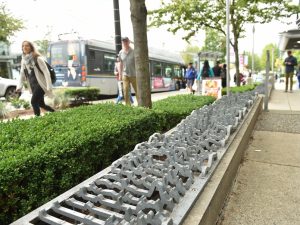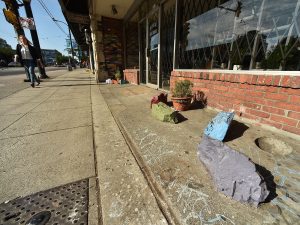The world is a scary place right now, and understandably so it is an extra scary place for folks experiencing homelessness in the midst of a pandemic. The government is requiring us to stay inside, to practice social distancing, and to avoid human interaction with the exception of acquiring essential services. For most of us, this means taking classes online, working from home, eating and drinking a lot more, and watching a whole lot more Netflix. But what about those who have nowhere to go? The government isn’t helping them now, and they certainly were not helping them before all this madness began.
Anti-homeless architecture is also referred to as “Defensive Design” and it is the intentional placing of objects and obstructions in public places with the aim to drive homeless folks out of the public eye. It can include dividers in park benches, coloured rocks in seemingly random places, and spikes in alleyways. These designs are constructed to look like harmless “art” installations so that these cities can appear as the problem-free utopias they like to present themselves as. Driving out homeless folks means that residents, tourists, and media will not have to confront the very real epidemic of homelessness that troubles most Canadian cities. Here are some examples of anti-homeless architecture:  (Both images courtesy of the Vancouver Courier)
(Both images courtesy of the Vancouver Courier)
 Besides these instances of defensive design, there are strategic policies in place that governments quietly pass to further hinder people experiencing homelessness. For example, shortly before the 2010 Vancouver Olympics the British Columbia Assistance to Shelter act was passed. Under the guise of empathy and humanity, these laws allowed police to force folks experiencing homelessness to stay at shelters or to enter various programs. These laws were put into place so that people who were visiting for the Olympics were ignorant of the homelessness problem in Vancouver. These shelters and programs are not always safe or inclusive for LGBTQ+ folks. Requirements for many shelters demand mandatory attendance of church sermons. For many, they are not feasible nor helpful. For example, most shelters require you to exit the premises by a certain time, requiring you to take all of your belongings with you. For people who work day jobs and do not want their employers to know that they are experiencing homelessness, this presents a significant problem.
Besides these instances of defensive design, there are strategic policies in place that governments quietly pass to further hinder people experiencing homelessness. For example, shortly before the 2010 Vancouver Olympics the British Columbia Assistance to Shelter act was passed. Under the guise of empathy and humanity, these laws allowed police to force folks experiencing homelessness to stay at shelters or to enter various programs. These laws were put into place so that people who were visiting for the Olympics were ignorant of the homelessness problem in Vancouver. These shelters and programs are not always safe or inclusive for LGBTQ+ folks. Requirements for many shelters demand mandatory attendance of church sermons. For many, they are not feasible nor helpful. For example, most shelters require you to exit the premises by a certain time, requiring you to take all of your belongings with you. For people who work day jobs and do not want their employers to know that they are experiencing homelessness, this presents a significant problem.
The Canadian Observatory on Homelessness is a fantastic resource when researching demographics, policies, and more information pertaining to homelessness. The website provides a breakdown for each province including statistics on the number of people experiencing homelessness (which is often under reported), vacancy rates, and statistics on indigenous folks experiencing housing issues. On top of researching the British Columbia’s Assistance to Shelter Act, I also looked at Ontario’s Safe Streets Act. The Act specifically targets instances of panhandling and issuing tickets to people sleeping outside. The Act was criticized for how vague its descriptions were, giving law enforcement officers too much leeway to aggressively police people experiencing homelessness.
Whenever we are permitted to leave our homes again and if you are able, take a stroll or trip downtown and keep an eye out for instances of defensive design. Research statistics about homelessness and read the first-hand experiences of people experiencing homelessness. But most of all, have empathy. Homeless folks are people too and deserve to be treated as such.





